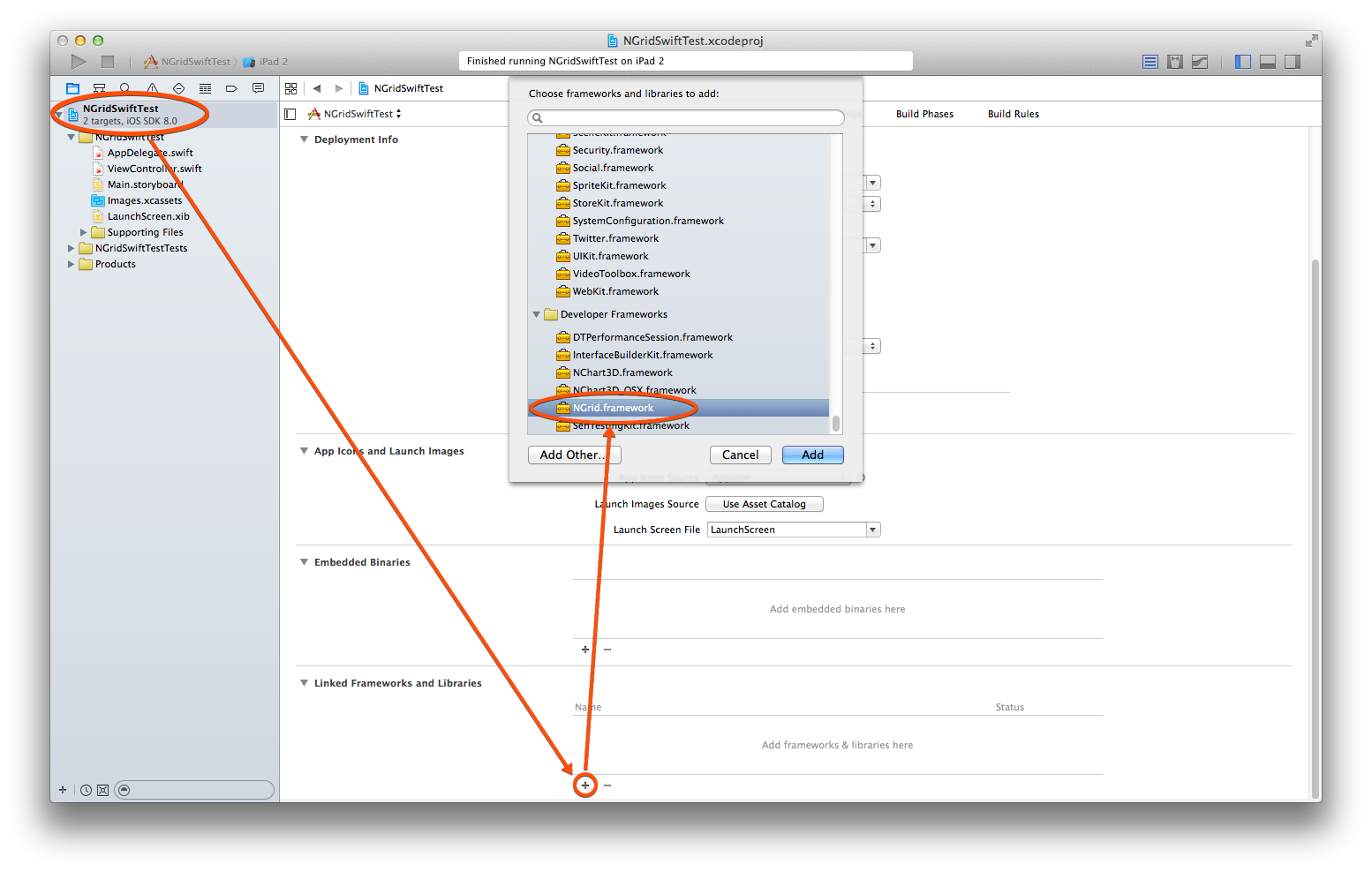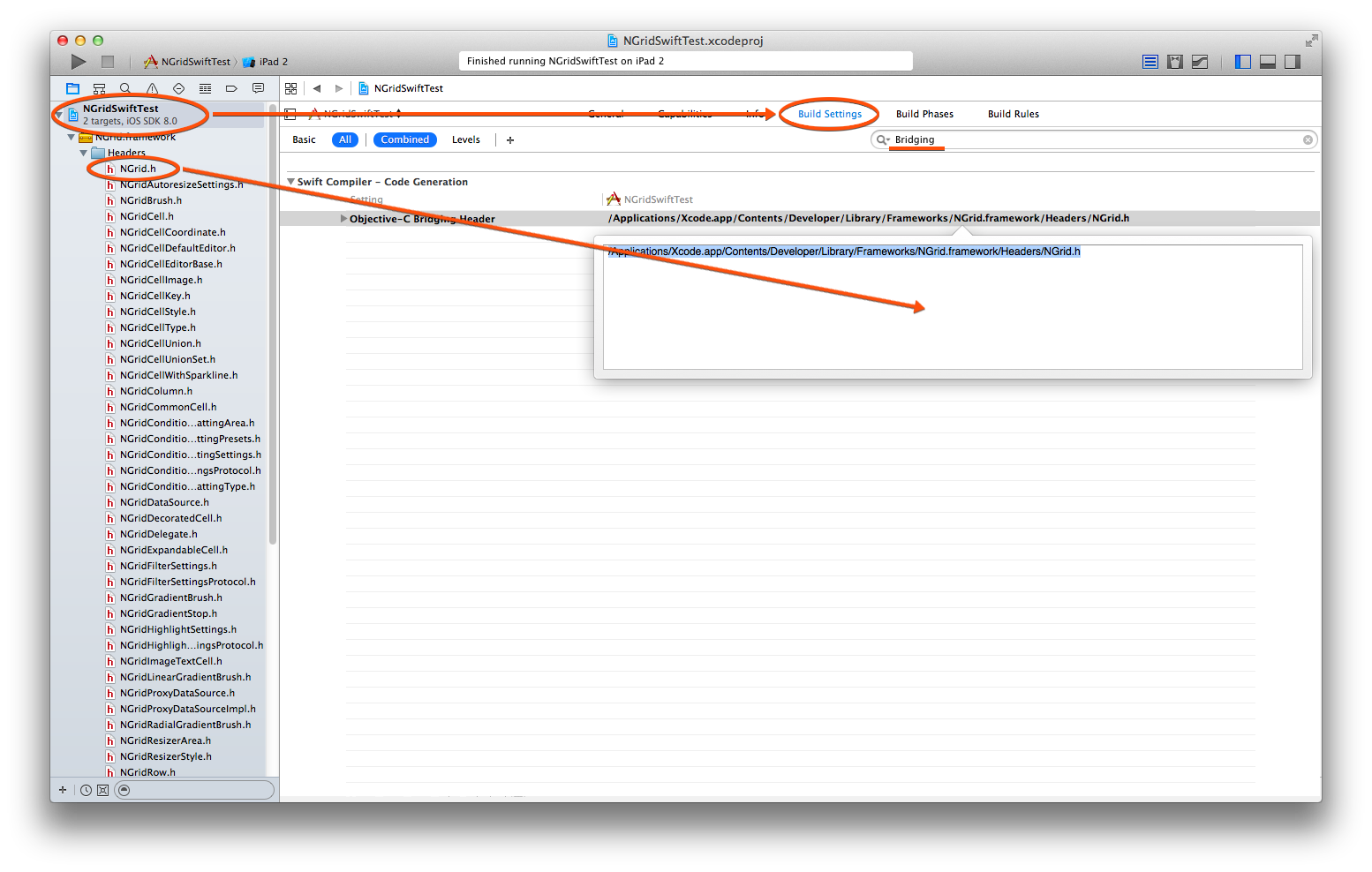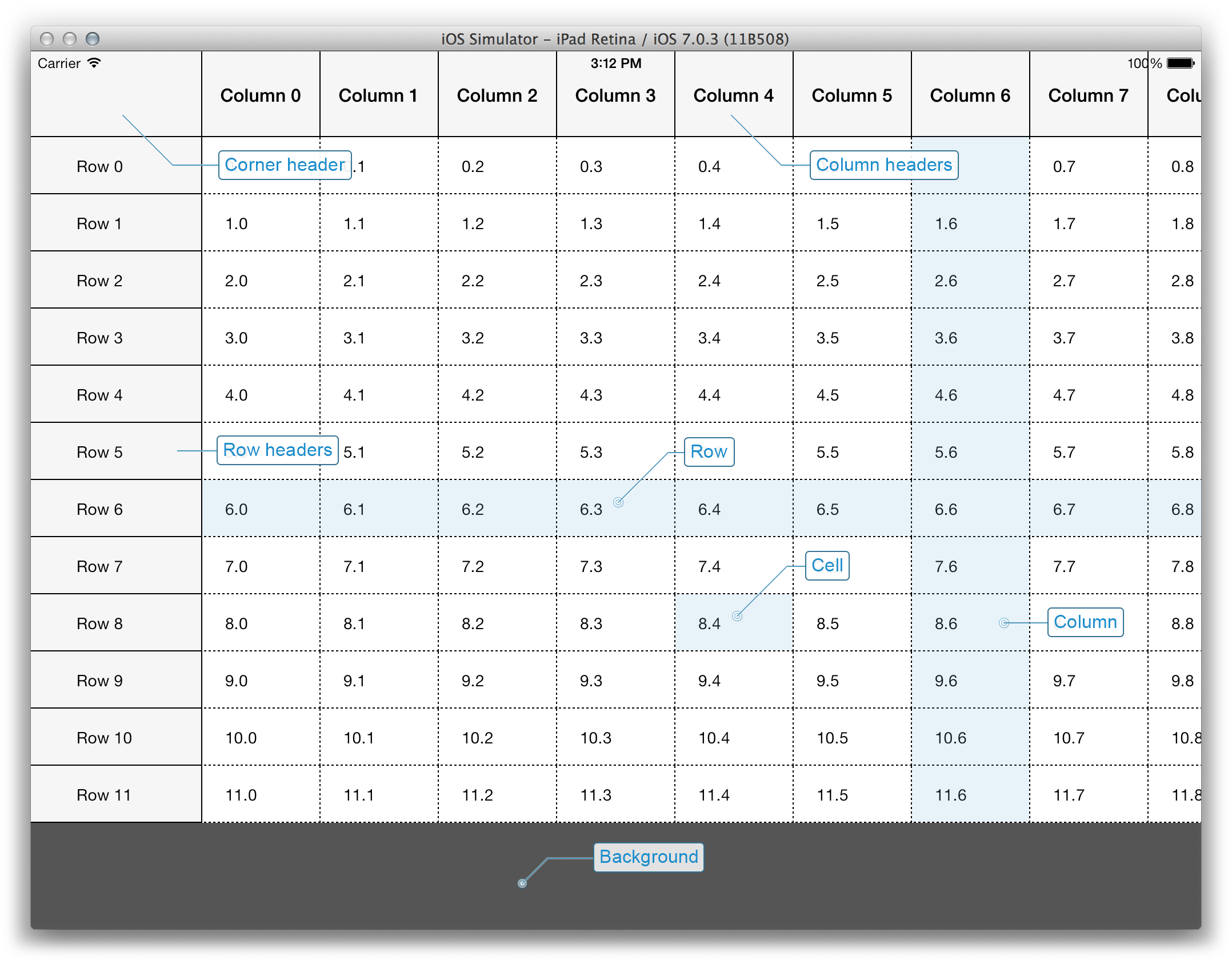NGrid Swift Tutorial
Overview
This short tutorial explains the main concepts of the NGrid framework and helps you learn how to create tables using NGrid.
NGrid is a powerful library to create tables, grids and spreadsheets. It’s easy to use, easy to customize, optimized for work with large datasets and include functions for data interaction and analysis.
Introduction
This tutorial will show you how to install NGrid framework and build a simple project that demonstrates core usage and customization capabilities. The tutorial is related with samples provided on the NGrid macOS .dmg that can be downloaded here.

Installation
First, download the NGrid macOS .dmg. It is recommended to install the framework as it will allow you to add it via the "Developer Frameworks" section in Xcode. To install the framework, run “Install.pkg”. Alternatively, you can just copy the framework to your disk and then link it through the “Add Other...” option. The framework is located in the “NGrid.framework” directory, its documentation is located in the “Documentation” directory, and the set of samples is located in the “NGrid/Swift-Samples” directory.
For each sample, there is a pre-made Xcode project, so you can check them out to see whether everything works properly.
However, in this tutorial you will learn how to create a project from scratch. Let’s begin!
Create a new project of the "Single View Application" type. At the next window select "Swift" in the language list.
If you installed the framework properly, you should be able to link it to your application in the usual way. Click the top-level element in your project’s tree (it contains the name of your project), select the tab "General", scroll down add hit the "+" button. Then find the NGrid.framework that should be in the "Developer Frameworks" section.
Double-click it, and it will be linked to your project.

Then, select the tab "Build Settings" and find property "Objective-C Bridging Header". Double click to it and drag and drop header named "NGrid.h" from NGrid.framework to this property. Press Enter button to confirm.

After that add the value $(DEVELOPER_FRAMEWORKS_DIR) to the set of values of the option "Framework search paths" in the project settings.
Make a test run to check whether the project is able to build and run.
Now your project is set up and you are ready to start using the NGrid framework!
Simple Sample
First of all, create a new project as explained in Installation paragraph. Open ViewController.swift file and find ViewController class (or create, if this file does not exist).
Now we can start creating our first NGrid application. We’ll use ViewController class as our main class providing data source and delegate functionality. For this purpose we should define ViewController class as implementing NGridDataSource and NGridDelegate protocols:
class ViewController: UIViewController, NGridDataSource, NGridDelegate// MARK: Data source stuff
func gridView(_ gridView: NGridView!, cellWith cellKey: NGridCellKey!) -> NGridCell! {
var cell = gridView.dequeueReusableCell(withIdentifier: "CellID") as! NGridCommonCell!
if (cell == nil) {
cell = NGridCommonCell(reuseIdentifier: "CellID")
}
let cellValue = self.gridView(gridView, valueForCellWith: cellKey)
cell?.text = "\(cellValue!)"
return cell
}
func gridView(_ gridView: NGridView!, valueForCellWith cellKey: NGridCellKey!) -> NSObject! {
var valuePrefix: String
switch cellKey.type {
case .cornerHeader:
valuePrefix = "Corner header"
case .columnHeader:
valuePrefix = "Column header"
case .rowHeader:
valuePrefix = "Row header"
case .regular:
valuePrefix = "Regular"
}
return "\(valuePrefix) \(cellKey.rowKey):\(cellKey.columnKey)" as NSObject!
}
func gridViewRowCount(_ gridView: NGridView!) -> Int {
return 15
}
func gridViewColumnCount(_ gridView: NGridView!) -> Int {
return 10
}
func gridViewRowHeaderCount(_ gridView: NGridView!) -> Int {
return 1
}
func gridViewColumnHeaderCount(_ gridView: NGridView!) -> Int {
return 1
}
// MARK: Delegate stuff
func gridView(_ gridView: NGridView!, widthForColumnWithKey columnKey: Int) -> CGFloat {
return 150.0
}
func gridView(_ gridView: NGridView!, heightForRowWithKey rowKey: Int) -> CGFloat {
return 50.0
}
func gridView(_ gridView: NGridView!, widthForHeaderRowWithKey key: Int) -> CGFloat {
return 200.0
}
func gridView(_ gridView: NGridView!, heightForHeaderColumnWithKey key: Int) -> CGFloat {
return 75.0
}Finally, we have to create and initialize NGridView and use our ViewController as a root controller of application window. For this purpose we can use
loadView and viewDidLoad methods of ViewController.override func loadView() {
self.view = NGridView()
}
override func viewDidLoad() {
super.viewDidLoad()
(self.view as! NGridView).licenseKey = ""
(self.view as! NGridView).dataSource = self
(self.view as! NGridView).delegate = self
(self.view as! NGridView).reloadData()
}Now we can build and run our application and see what happens.

Customizing Appearance
The resulting table displays data but doesn’t look pretty enough. To fix it, let’s try to use NGrid style engine: set alignment and padding, change colors and fonts, configure borders, etc. In order to do this, we should define styles for row headers, column headers, and for regular cells.
Style for column header is shown below.
let columnHeaderCellStyle = NGridCellStyle.empty()!
columnHeaderCellStyle.backgroundColor = UIColor(red: 246.0/255.0, green: 246.0/255.0, blue: 246.0/255.0, alpha: 1.0)
columnHeaderCellStyle.setBorderColor(UIColor(red: 195.0/255.0, green: 195.0/255.0, blue: 195.0/255.0, alpha: 1.0))
columnHeaderCellStyle.textAlignment = NSTextAlignment.center;
columnHeaderCellStyle.textColor = UIColor(red: 50.0/255.0, green: 50.0/255.0, blue: 55.0/255.0, alpha: 1.0)
columnHeaderCellStyle.font = UIFont.boldSystemFont(ofSize: 14.0)
columnHeaderCellStyle.leftPadding = 7.0
columnHeaderCellStyle.rightPadding = 7.0let rowHeaderCellSyle = columnHeaderCellStyle.copy() as! NGridCellStyle
rowHeaderCellSyle.leftPadding = 25.0
rowHeaderCellSyle.textAlignment = NSTextAlignment.leftlet regularCellStyle = NGridCellStyle.default()!
regularCellStyle.textAlignment = NSTextAlignment.right
regularCellStyle.font = UIFont.systemFont(ofSize: 14.0)
regularCellStyle.textColor = UIColor(red: 70.0/255.0, green: 70.0/255.0, blue: 75.0/255.0, alpha: 1.0)
regularCellStyle.setBorderColor(UIColor(red: 195.0/255.0, green: 195.0/255.0, blue: 195.0/255.0, alpha: 1.0))
regularCellStyle.rightBorderDash = [1, 1]
regularCellStyle.bottomBorderDash = [1, 1]
regularCellStyle.leftBorderWidth = 0
regularCellStyle.rightBorderWidth = 1.0
regularCellStyle.leftPadding = 7.0
regularCellStyle.rightPadding = 7.0
regularCellStyle.backgroundColorInterchange = true
regularCellStyle.firstInterchangedColor = UIColor(red: 253.0/255.0, green: 253.0/255.0, blue: 253.0/255.0, alpha: 1.0)
regularCellStyle.secondInterchangedColor = UIColor.whiteUse styleLevel: to get any style level from the style manager. It receives NGridStyleLevelOrder value as parameter.
The level objects are the instances of NGridStyleLevel class. It contains methods to specify the style of any of the grid elements.
let styleManager = (gridView.proxyDataSource as! NGridProxyDataSourceImpl).styleManager()!
let styleLevel = styleManager.styleLevel(NGridStyleLevelOrder.level0)!
styleLevel.setDefaultStyleForColumnHeader(columnHeaderCellStyle)
styleLevel.setDefaultStyleForRowHeader(rowHeaderCellSyle)
styleLevel.setDefaultStyle(regularCellStyle)func setupAppearance(_ gridView: NGridView) {
let columnHeaderCellStyle = NGridCellStyle.empty()!
columnHeaderCellStyle.backgroundColor = UIColor(red: 246.0/255.0, green: 246.0/255.0, blue: 246.0/255.0, alpha: 1.0)
columnHeaderCellStyle.setBorderColor(UIColor(red: 195.0/255.0, green: 195.0/255.0, blue: 195.0/255.0, alpha: 1.0))
columnHeaderCellStyle.textAlignment = NSTextAlignment.center;
columnHeaderCellStyle.textColor = UIColor(red: 50.0/255.0, green: 50.0/255.0, blue: 55.0/255.0, alpha: 1.0)
columnHeaderCellStyle.font = UIFont.boldSystemFont(ofSize: 14.0)
columnHeaderCellStyle.leftPadding = 7.0
columnHeaderCellStyle.rightPadding = 7.0
let rowHeaderCellSyle = columnHeaderCellStyle.copy() as! NGridCellStyle
rowHeaderCellSyle.leftPadding = 25.0
rowHeaderCellSyle.textAlignment = NSTextAlignment.left
let regularCellStyle = NGridCellStyle.default()!
regularCellStyle.textAlignment = NSTextAlignment.right
regularCellStyle.font = UIFont.systemFont(ofSize: 14.0)
regularCellStyle.textColor = UIColor(red: 70.0/255.0, green: 70.0/255.0, blue: 75.0/255.0, alpha: 1.0)
regularCellStyle.setBorderColor(UIColor(red: 195.0/255.0, green: 195.0/255.0, blue: 195.0/255.0, alpha: 1.0))
regularCellStyle.rightBorderDash = [1, 1]
regularCellStyle.bottomBorderDash = [1, 1]
regularCellStyle.leftBorderWidth = 0
regularCellStyle.rightBorderWidth = 1.0
regularCellStyle.leftPadding = 7.0
regularCellStyle.rightPadding = 7.0
regularCellStyle.backgroundColorInterchange = true
regularCellStyle.firstInterchangedColor = UIColor(red: 253.0/255.0, green: 253.0/255.0, blue: 253.0/255.0, alpha: 1.0)
regularCellStyle.secondInterchangedColor = UIColor.white
let styleManager = (gridView.proxyDataSource as! NGridProxyDataSourceImpl).styleManager()!
let styleLevel = styleManager.styleLevel(NGridStyleLevelOrder.level0)!
styleLevel.setDefaultStyleForColumnHeader(columnHeaderCellStyle)
styleLevel.setDefaultStyleForRowHeader(rowHeaderCellSyle)
styleLevel.setDefaultStyle(regularCellStyle)
}override func viewDidLoad() {
super.viewDidLoad()
(self.view as! NGridView).licenseKey = ""
(self.view as! NGridView).dataSource = self
(self.view as! NGridView).delegate = self
setupAppearance(self.view as! NGridView)
(self.view as! NGridView).reloadData()
}
What's next?
You can find the full source code from this tutorial and the other information about using the NGrid framework in the samples in macOS .dmg. If you have any questions, feel free to contact us.
